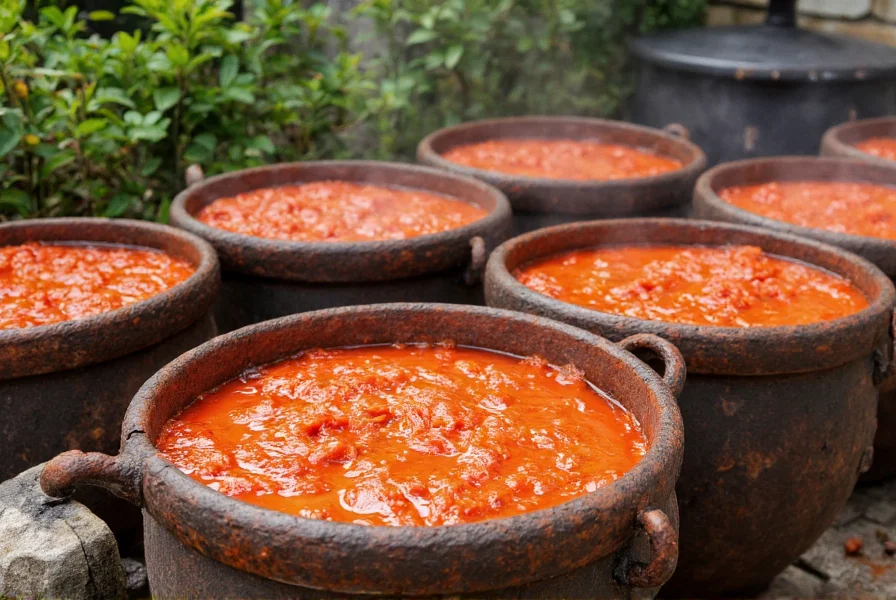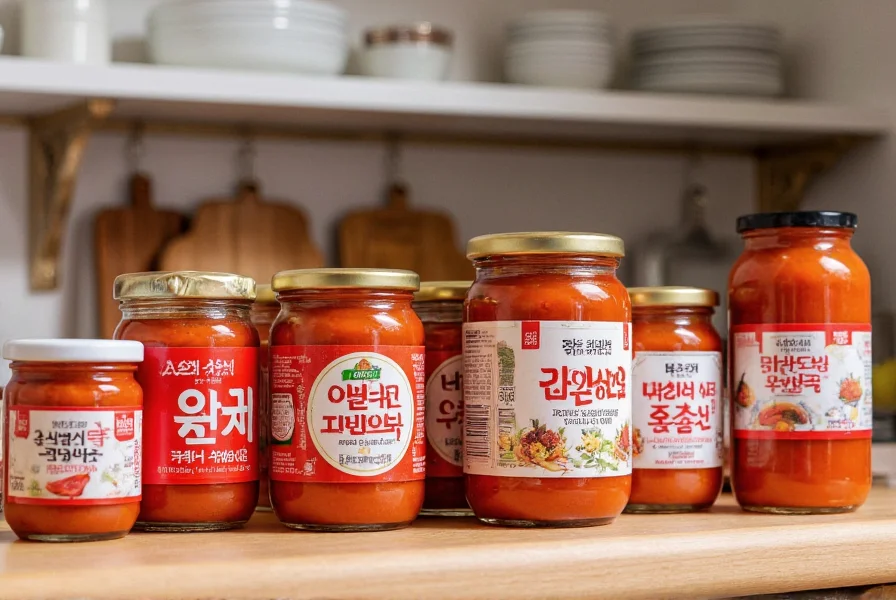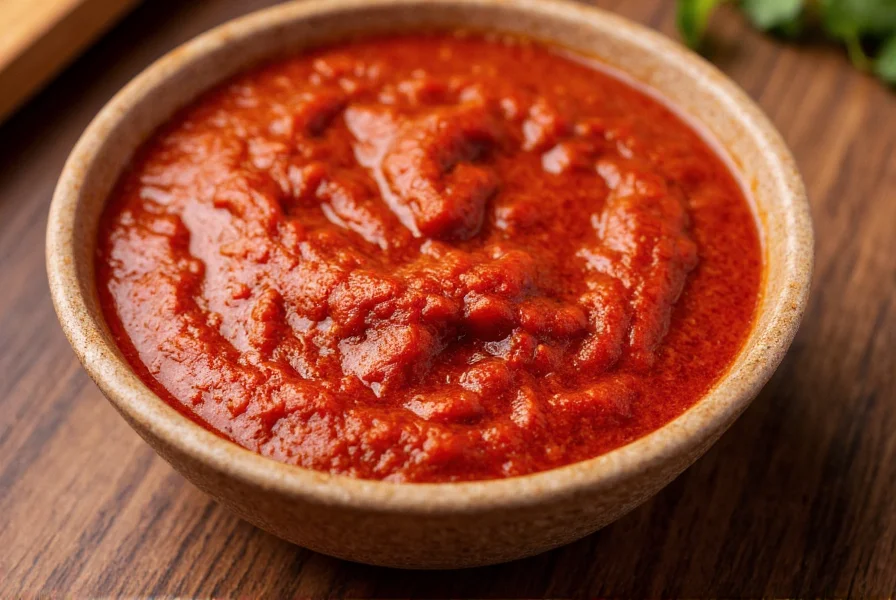Understanding korean red pepper paste ingredients reveals why it's so distinctive. Traditional gochujang combines gochugaru (Korean red pepper flakes), meju-garu (fermented soybean powder), glutinous rice powder, and salt. The mixture undergoes fermentation for months or even years, developing its characteristic deep red color and complex flavor. Unlike many Western hot sauces, gochujang isn't primarily about heat—it's about depth of flavor that enhances rather than overwhelms dishes.
What Sets Gochujang Apart from Similar Products
Many confuse korean red pepper paste with gochugaru, but they're fundamentally different. Gochugaru is the dried red pepper flakes used to make gochujang, while gochujang itself is the finished fermented paste. Gochujang also differs from Japanese miso (though both use fermented soybeans) and Chinese doubanjiang (which typically uses broad beans instead of rice).
| Product | Base Ingredients | Texture | Primary Flavor Profile |
|---|---|---|---|
| Gochujang | Chili powder, rice, soybeans, salt | Thick paste | Spicy, sweet, umami |
| Gochugaru | Dried red peppers | Flakes or powder | Spicy, slightly sweet |
| Doubanjiang | Fermented broad beans, chili | Chunky paste | Salty, spicy, fermented |
Traditional Production Methods
Authentic korean fermented chili paste production begins with sun-dried red peppers ground into gochugaru. The paste ferments in onggi (traditional Korean earthenware pots) buried partially in the ground, allowing natural temperature regulation. This slow fermentation process—often lasting 6 months to 3 years—creates the complex enzymatic reactions that develop gochujang's signature flavor. Modern commercial production accelerates this process but often sacrifices some depth of flavor.

Culinary Applications in Korean Cooking
Learning how to use gochujang in cooking opens up authentic Korean flavors. It serves as the base for:
- Tteokbokki (chewy rice cake stir-fry)
- Budae jjigae ("army stew")
- Gochujang marinades for meats
- Bibimbap sauce
- Stir-fries and braises
Chefs often blend gochujang with other ingredients like sesame oil, garlic, and vinegar to balance its intensity. When incorporating it into dishes, add gochujang early in the cooking process to mellow its raw heat while preserving its complex flavors.
Nutritional Profile and Health Considerations
While not a health supplement, traditional korean red pepper paste benefits include:
- Naturally occurring probiotics from fermentation
- Vitamin C from red peppers
- Antioxidants from capsaicin
- Plant-based protein from fermented soybeans
Commercial varieties often contain added sugar, so checking labels is advisable for those monitoring sugar intake. Authentic gochujang derives its sweetness naturally from the fermentation of rice starches.
Selecting and Storing Authentic Gochujang
When determining where to buy authentic gochujang, look for:
- Ingredients listing only chili powder, rice, soybeans, and salt
- Deep crimson color (not bright red)
- "Fermented" on the label
- Korean language on packaging
Store unopened containers in a cool, dark place. Once opened, keep gochujang refrigerated in an airtight container where it will maintain quality for 1-2 years. The surface may darken slightly, but this doesn't indicate spoilage.

Substituting Gochujang When Unavailable
Understanding korean red pepper paste substitutes helps when authentic gochujang isn't accessible. While no substitute perfectly replicates its complex flavor, these combinations work in a pinch:
- Mix 1 tbsp red pepper flakes + 1 tbsp miso paste + 1 tsp sugar + 1 tsp rice vinegar
- Combine 1 tbsp harissa + 1 tbsp tomato paste + 1 tsp honey
- Blend 1 tbsp sambal oelek + 1 tbsp soybean paste + 1 tsp maple syrup
Remember that substitutes won't provide the same depth from traditional fermentation, so adjust quantities carefully based on the dish you're preparing.
Exploring Gochujang Beyond Traditional Korean Dishes
Modern chefs increasingly incorporate korean fermented chili paste into fusion cuisine. Try it in:
- Barbecue sauces and glazes
- Mayonnaise for sandwiches and burgers
- Marinades for roasted vegetables
- Stir-fry sauces with a global twist
- As a flavor booster in soups and stews
The key to successful fusion is using gochujang sparingly at first, then adjusting to taste. Its umami richness enhances many non-Korean dishes without making them taste overtly Korean.
Frequently Asked Questions
What is the difference between gochujang and sriracha?
Gochujang is a thick, fermented Korean chili paste made from red pepper powder, rice, and soybeans, offering complex sweet-spicy-umami flavors. Sriracha is a thinner, vinegar-based Southeast Asian hot sauce made primarily from chili peppers, garlic, and vinegar, with a sharper, more acidic heat profile. Gochujang contains fermented elements and natural sweetness, while sriracha relies on sugar and vinegar for balance.
Is gochujang gluten-free?
Traditional gochujang contains glutinous rice, which is naturally gluten-free. However, some commercial varieties may include wheat-based ingredients or be processed in facilities with gluten. Always check labels if you require strictly gluten-free products, as manufacturing processes vary between brands. Authentic Korean-made gochujang typically remains gluten-free, but imported versions sometimes modify recipes for different markets.
How spicy is Korean red pepper paste?
Korean red pepper paste (gochujang) ranges from mild to moderately spicy, typically measuring 1,500-3,000 on the Scoville scale. Its heat is balanced by natural sweetness from fermented rice and umami from soybeans, making it less aggressively hot than many Western hot sauces. The fermentation process mellows the raw heat of the chili peppers while developing complex flavors. Individual tolerance varies, but most find gochujang's heat approachable compared to pure chili flakes or hotter sauces.
Can I make gochujang at home?
Yes, though traditional homemade gochujang requires significant time and specific ingredients. The basic process involves mixing Korean red pepper flakes (gochugaru), fermented soybean powder (meju-garu), glutinous rice powder, and salt with water, then fermenting the mixture for 6 months to 3 years. Modern simplified versions use miso paste as a fermentation starter and reduce fermentation time to weeks, though they lack the depth of traditionally made paste. Authentic production requires specific Korean ingredients that may be difficult to source outside Korea.











 浙公网安备
33010002000092号
浙公网安备
33010002000092号 浙B2-20120091-4
浙B2-20120091-4